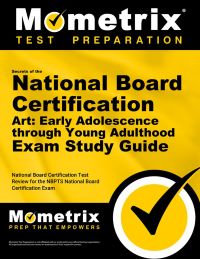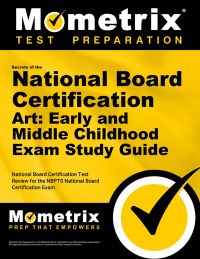National Board Certification English as a New Language: Early Adolescence through Young Adulthood Exam
Study Guide And Test Preparation For National Board Certification Art: Early Adolescence through Young Adulthood Exam
A Complete National Board Certification Art: Early Adolescence through Young Adulthood Exam Study Guide that includes sample questions, test tips and a complete study plan prepared by a team of expert and dedicated researchers. Cost-effective and qualified exam help from a committed exam preparation company.
National Board Certification Art: Early and Middle Childhood Exam
The National Board Certification for Art: Early and Middle Childhood is a prestigious credential that recognizes accomplished teaching in the field of art education. This certification is part of the National Board for Professional Teaching Standards (NBPTS) program, which aims to advance the quality of teaching and learning by maintaining high and rigorous standards for what accomplished teachers should know and be able to do. Achieving this certification demonstrates a teacher's commitment to excellence in art education for young learners, spanning from early childhood to middle childhood.
Eligibility
To be eligible for the National Board Certification in Art: Early and Middle Childhood, candidates must meet several criteria. Firstly, they must hold a bachelor's degree from an accredited institution. Secondly, candidates are required to have completed at least three years of successful teaching experience at the early or middle childhood levels. This experience must be in a school setting recognized by the state or local authority. Additionally, candidates must possess a valid state teaching license if it is required by their state. These prerequisites ensure that candidates have the foundational knowledge and practical experience necessary to pursue certification.
Syllabus
The syllabus for the National Board Certification in Art: Early and Middle Childhood is designed to assess a teacher's proficiency in delivering quality art education. The certification process is structured around four components, each focusing on different aspects of teaching practice:
- Component 1: Content Knowledge
This component evaluates the candidate's understanding of art content and pedagogy. It includes a computer-based assessment with constructed response exercises and selected response items. Teachers are expected to demonstrate their knowledge of art concepts, techniques, and the ability to apply this knowledge in an educational setting. - Component 2: Differentiation in Instruction
This component requires candidates to submit a portfolio entry that highlights their ability to differentiate instruction. Teachers must provide evidence of how they adapt their teaching strategies to meet the diverse needs of students in their classroom. This includes planning and implementing lessons that accommodate various learning styles and abilities. - Component 3: Teaching Practice and Learning Environment
For this component, candidates must submit video recordings of their teaching practice. These videos should demonstrate effective teaching strategies and classroom management skills. Accompanying the videos, candidates must provide written commentary reflecting on their instructional decisions and the impact on student learning. - Component 4: Effective and Reflective Practitioner
This component focuses on the teacher's ability to reflect on their practice and contribute to their professional learning community. Candidates are required to compile evidence of their professional growth and engagement with colleagues, families, and the wider community. This may include participation in professional development activities, collaboration with peers, and involvement in initiatives that enhance art education.
Format of the Exam
The National Board Certification process for Art: Early and Middle Childhood is comprehensive and multifaceted, designed to evaluate a teacher's proficiency in both theoretical knowledge and practical application. The process is divided into the four components mentioned above, each with specific requirements and formats.
Component 1: Content Knowledge
The content knowledge assessment is conducted through a computer-based test administered at a designated testing center. This component consists of a combination of constructed response exercises and selected response items. The constructed response exercises require candidates to analyze scenarios and provide written responses demonstrating their understanding of art education concepts. The selected response items are multiple-choice questions that assess the candidate's breadth of knowledge in art content and pedagogy.
Component 2: Differentiation in Instruction
For this component, candidates must submit a portfolio entry that includes student work samples, instructional materials, and written commentary. The portfolio should showcase the teacher's ability to design and implement lessons that cater to diverse student needs. Candidates must provide evidence of how they assess student learning and adjust their teaching strategies accordingly.
Component 3: Teaching Practice and Learning Environment
Candidates are required to submit video recordings of their teaching sessions, accompanied by written commentary. The videos should capture the teacher's interaction with students, instructional techniques, and classroom management strategies. The written commentary should reflect on the teacher's instructional decisions and their impact on student learning. This component emphasizes the teacher's ability to create a supportive and engaging learning environment.
Component 4: Effective and Reflective Practitioner
This component involves compiling evidence of the teacher's professional growth and contributions to the educational community. Candidates must submit documentation of their involvement in professional development activities, collaboration with colleagues, and engagement with families and the community. The written commentary should highlight the teacher's reflective practice and commitment to continuous improvement.
Conclusion
The National Board Certification for Art: Early and Middle Childhood is a rigorous and rewarding process that validates a teacher's expertise and dedication to art education. By achieving this certification, teachers demonstrate their commitment to providing high-quality art instruction to young learners, fostering creativity, critical thinking, and a lifelong appreciation for the arts. The certification process not only enhances the teacher's professional growth but also contributes to the advancement of the teaching profession as a whole.
Study Guide And Test Preparation For National Board Certification Art: Early and Middle Childhood Exam
A Complete National Board Certification Art: National Board Certification Art Early and Middle Childhood Exam Study Guide that includes sample questions, test tips and a complete study plan prepared by a team of expert and dedicated researchers. Cost-effective and qualified exam help from a committed exam preparation company.
National Board Certification Art: Early Adolescence through Young Adulthood Exam
The National Board Certification for Art: Early Adolescence through Young Adulthood is a prestigious certification that recognizes accomplished teachers who meet high and rigorous standards. This certification is designed for art educators teaching students aged approximately 11 to 18+ years. Achieving National Board Certification signifies that a teacher has demonstrated the advanced knowledge, skills, and practices required of an outstanding educator. The certification process is a comprehensive assessment that evaluates a teacher's ability to deliver quality education and foster student learning in the field of art.
Eligibility
To be eligible for the National Board Certification in Art: Early Adolescence through Young Adulthood, candidates must meet specific requirements. Firstly, candidates must hold a bachelor's degree from an accredited institution. Secondly, they must have completed at least three years of successful teaching experience in art education, working with students within the specified age range. Additionally, candidates must possess a valid state teaching license for the subject and age group they are applying for. Meeting these eligibility criteria ensures that candidates have the foundational experience and qualifications necessary to undertake the rigorous certification process.
Syllabus
The syllabus for the National Board Certification in Art is designed to assess a teacher's competency in various areas critical to effective art education. The certification process is structured around the National Board's Five Core Propositions, which serve as guiding principles for accomplished teaching. These propositions include:
- Commitment to Students and Their Learning: Candidates must demonstrate an understanding of their students' diverse backgrounds, interests, and learning needs. They should be able to create an inclusive and supportive learning environment that fosters student engagement and growth.
- Knowledge of Content and Pedagogy: Candidates are expected to possess a deep understanding of art content and pedagogical strategies. They should be able to effectively convey complex concepts, techniques, and historical contexts to their students.
- Managing and Monitoring Student Learning: This involves using various assessment methods to evaluate student progress and adapt instruction accordingly. Candidates must show their ability to design and implement lessons that promote critical thinking and creativity.
- Reflective Practice and Learning from Experience: Teachers should engage in continuous self-reflection and professional development to enhance their teaching practices. Candidates must demonstrate how they have used their experiences to improve their instructional methods.
- Participation in Learning Communities: Candidates should actively engage with colleagues, parents, and the broader educational community to support student learning. This includes participating in collaborative projects, sharing best practices, and advocating for the arts.
Format of the Exam
The National Board Certification process for Art: Early Adolescence through Young Adulthood consists of four components that assess different aspects of teaching practice. These components are designed to provide a comprehensive evaluation of a candidate's abilities and are completed over a period of time.
- Component 1: Content Knowledge This is a computer-based assessment that evaluates a candidate's knowledge of art content and pedagogy. It consists of multiple-choice questions and constructed response items that cover various topics such as art history, theory, techniques, and instructional strategies.
- Component 2: Differentiation in Instruction In this component, candidates are required to submit a portfolio entry that demonstrates their ability to differentiate instruction to meet the diverse needs of students. This includes providing evidence of how they adapt their teaching methods and materials to support individual learning styles and abilities.
- Component 3: Teaching Practice and Learning Environment This component involves the submission of video recordings of classroom teaching, along with written reflections. Candidates must showcase their ability to create an effective learning environment, engage students in meaningful art experiences, and reflect on their teaching practices to improve student outcomes.
- Component 4: Effective and Reflective Practitioner The final component requires candidates to submit evidence of their professional growth and contributions to the learning community. This includes documentation of professional development activities, collaboration with colleagues, and efforts to advocate for the arts in education. Candidates must reflect on how these experiences have influenced their teaching and student learning.
Each component is scored individually, and candidates must achieve a minimum score in each area to earn certification. The assessment process is rigorous and requires candidates to provide detailed evidence of their teaching practices and student learning outcomes.
Conclusion
The National Board Certification for Art: Early Adolescence through Young Adulthood is a valuable credential that recognizes the expertise and dedication of art educators. It provides teachers with the opportunity to reflect on their practice, enhance their skills, and contribute to the advancement of the teaching profession. By achieving this certification, teachers demonstrate their commitment to providing high-quality art education and fostering the creative potential of their students. The certification process is challenging but rewarding, offering educators the chance to join a community of accomplished teachers who are dedicated to excellence in teaching and learning.
Study Guide And Test Preparation For National Board Certification Art: Early Adolescence through Young Adulthood Exam
A Complete National Board Certification Art: Early Adolescence through Young Adulthood Exam Study Guide that includes sample questions, test tips and a complete study plan prepared by a team of expert and dedicated researchers. Cost-effective and qualified exam help from a committed exam preparation company.


